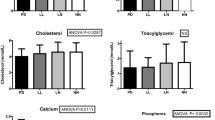Abstract
Of the 72 pancreatic preparations currently on the market 24 were randomly selected for study and compared with 3 US preparations with different dosage forms. The activities of amylase, lipase, and proteases were measured with natural substrates. Prospective bioavailability was determined using amylase as indicator enzyme. Total bile acid content and distribution pattern were analyzed. The risk of renal changes due to prolonged ingestion of purines was estimated by qualitative and quantitative determination of these contaminants.
Enzyme activities differed up to 16-fold. At pH 6, the drugs released the indicator enzyme with very different velocities. The efficacy of the drugs varied between 0.78% and 80.9%. The bioavailability of capsules was generally better than that of coated tablets; pellet capsules were not absolutely superior in this regard. All pancreatic preparations contained the purine bases guanine and hypoxanthine; only one drug had no adenine. Fifteen drugs contained 2.2%–10.6% bile acids by weight. Monohydroxy bile acids, which should not be administered to pateints with liver disease, were detected in eight of these preparations.
Similar content being viewed by others
References
Berndt W, Müller-Wieland K, Staudt U, Meier-Cabell E (1970) Beurteilung der Qualität von 5 Fermentsubstitutionspräparaten. Med Klin 65:2281–2285
Berndt W, Maas R, Straßner A (1977) Enzymmuster des exokrinen Pankreas verschiedener Spezies und ihre Bedeutung für die Fermentsubstitutionstherapie. Therapiewoche 27:6090–6107
Camilleri M, Murphy R, Chadwick VS (1980) Dose-related effects of chenodeoxycholic acid in the rabbit colon. Dig Dis Sci 25: 433–438
Ceska M, Brown B, Birath K (1969) Ranges of alpha-amylase activities in human serum and urine and correlations with some other alpha-amylase methods. Clin Chim Acta 26:445–453
Dibbern HW, Wirbitzki E (1971) Kritischer Vergleich verschiedener Methoden zur Bestimmung der Auflösungsgeschwindigkeit. Pharmaz Ztg 116:1848–1853
Di Magno EP (1982) Controversies in the treatment of exocrine pancreatic insufficiency. Dig Dis Sci 27:481–483
Di Magno EP, Malagelada JR, Go VLW, Moertel CG (1977) Fate of orally ingested enzymes in pancreatic insufficiency. Comparison of two dosage schedules. N Engl J Med 296:1318–1322
Fraser GP, Nicol AD (1966) Studies on pancreatic lipase. Clin Chim Acta 13:552–562
Graham DY (1977) Enzyme replacement therapy of exocrine pancreatic insufficiency in man. N Engl J Med 296:1314–1317
Graham DY (1979) An enteric-coated pancreatic enzyme preparation that works. Dig Dis Sci 24:906–909
Grözinger KH, Volkwein A, Böhler R (1972) Untersuchungen zur Verdauungswirkung von Enzymsubstitutionspräparaten. Med Klin 67:458–461
Ihse I, Lilja P, Lundquist I (1980) Intestinal concentrations of pancreatic enzymes following pancreatic replacement therapy. Scand J Gastroenterol 15:137–144
Littman A, Hanscom DH (1969) Pancreatic extracts. N Engl J Med 281:201–204
McJunkin B, Fromm H, Sarva RP, Amin P (1981) Factors in the mechanism of diarrhea in bile acid malabsorption: Fecal pH-a key determinant. Gastroenterology 80:1454–1464
Meyer JH (1977) The ins and outs of oral pancreatic enzymes. N Engl J Med 296:1347–1348
Mischler EH, Parrell S, Farrell PM, Odell GB (1982) Comparison of effectiveness of pancreatic enzyme preparations in cystic fibrosis. Am J Dis Child 136:1060–1063
Möller H (1979) Vergleichende Untersuchungen von Pankreatin-Fertigarzneimitteln. Pharmaz Ztg 124:2279–2286
Möller H (1980) Pharmazeutische Verfügbarkeit von Pankreatin-Fertigarzneimitteln. Pharmaz Ztg 125:2254–2258
Niessen KH, Wolf A (1982) Studies on the cause of hyperuricosuria in cystic fibrosis patients. J Pediatr Gastroenterol Nutr 1: 349–354
Nousia-Arvanitakis S, Stapleton FB, Linshaw MA, Kennedy J (1977) Therapeutic approach to pancreatic extract-induced hyperuricosuria in cystic fibrosis. J Pediatr 90:302–305
Palmer RH (1978) Toxic effects of lithocholate on the liver and biliary tree. In: Taylor W (ed) The hepatobiliary system. Plenum Press, New York, pp 227–243
Rick W (1974) Trypsin-Bestimmung mit Hämoglobin und Casein als Substrat. In: Bergmeyer HU (Hrsg) Methoden der enzymatischen Analyse. Verlag Chemie, Weinheim, S 1052–1059
Rick W, Stegbauer HP (1974) α-Amylase-Messung der reduzierenden Gruppen. In: Bergmeyer HU (Hrsg) Methoden der enzymatischen Analyse. Verlag Chemie, Weinheim, S 918–923
Sack J, Blau J, Goldfarb D, Ben-Zaray D, Katznelson D (1980) Hyperuricosuria in cystic fibrosis patients treated with pancreatic enzyme supplements. A study of 16 patients in Israel. Irs J Med Sci 16:417–419
Schmidt H, Stork B, von Dahl KK (1974) Lipase-Photometrische Messung. In: Bergmeyer HU (Hrsg) Methoden der enzymatischen Analyse. Verlag Chemie, Weinheim, S 848–853
Usui T (1963) Thin-layer chromatography of bile acids with special reference to separation of keto-bile acids. J Biochem 54: 283–286
Willstätter R, Waldschmitz-Leitz E, Dunaiturria S, Künster G (1926) Zur Kenntnis des Trypsins. Hoppe-Seylers Z Physiol Chem 161:191–209
Yousef JM, Tuchweber B, Vonk RJ, Massé D, Audet M, Roy CC (1981) Lithocholate cholestasis: sulfated glycolithocholateinduced intrahepatic cholestasis in rats. Gastroenterology 80: 233–241
Author information
Authors and Affiliations
Rights and permissions
About this article
Cite this article
Niessen, K.H., König, J., Molitor, M. et al. Studies on the quality of pancreatic preparations: Enzyme content, prospective bioavailability, bile acid pattern, and contamination with purines. Eur J Pediatr 141, 23–29 (1983). https://doi.org/10.1007/BF00445663
Received:
Accepted:
Issue Date:
DOI: https://doi.org/10.1007/BF00445663




